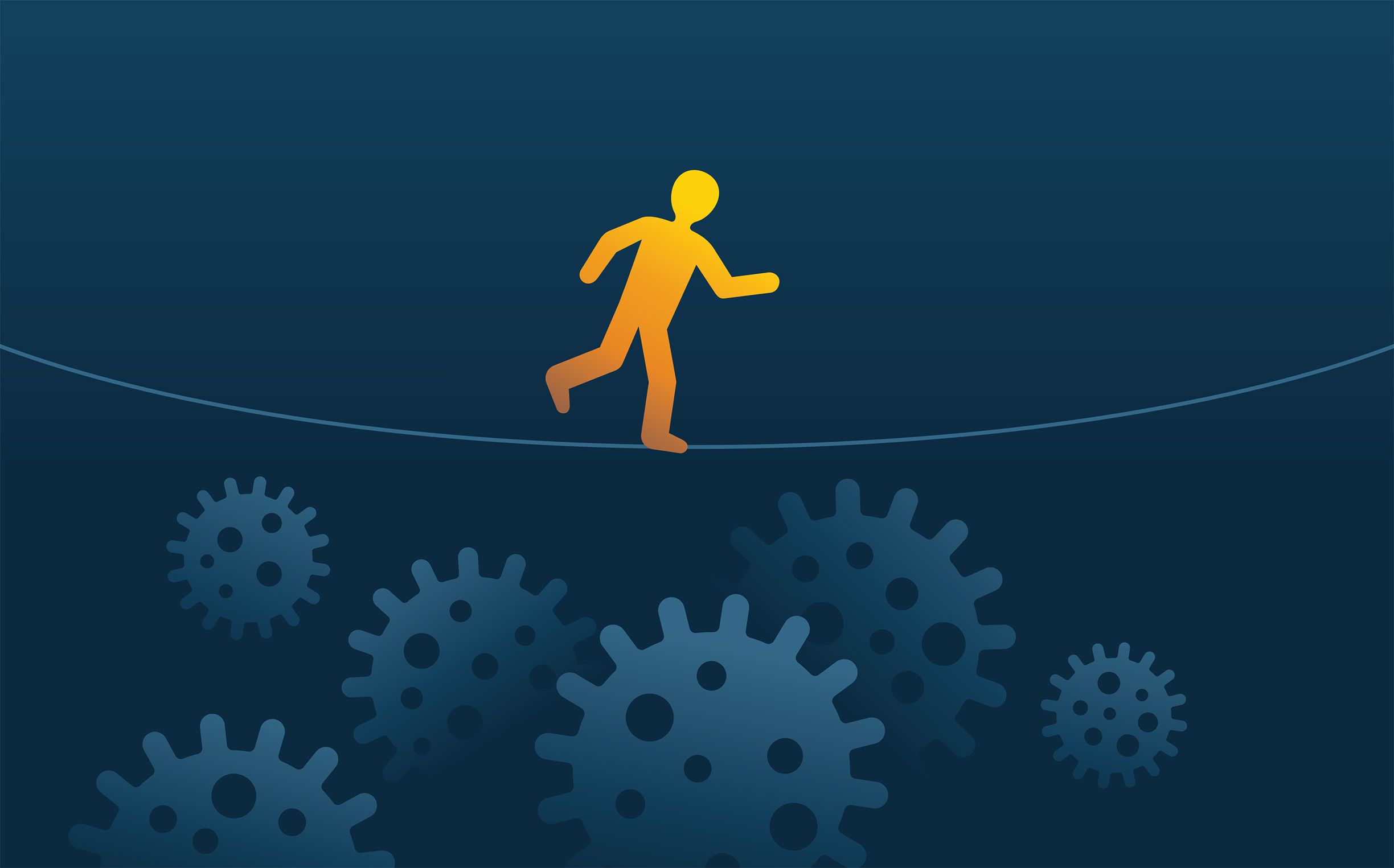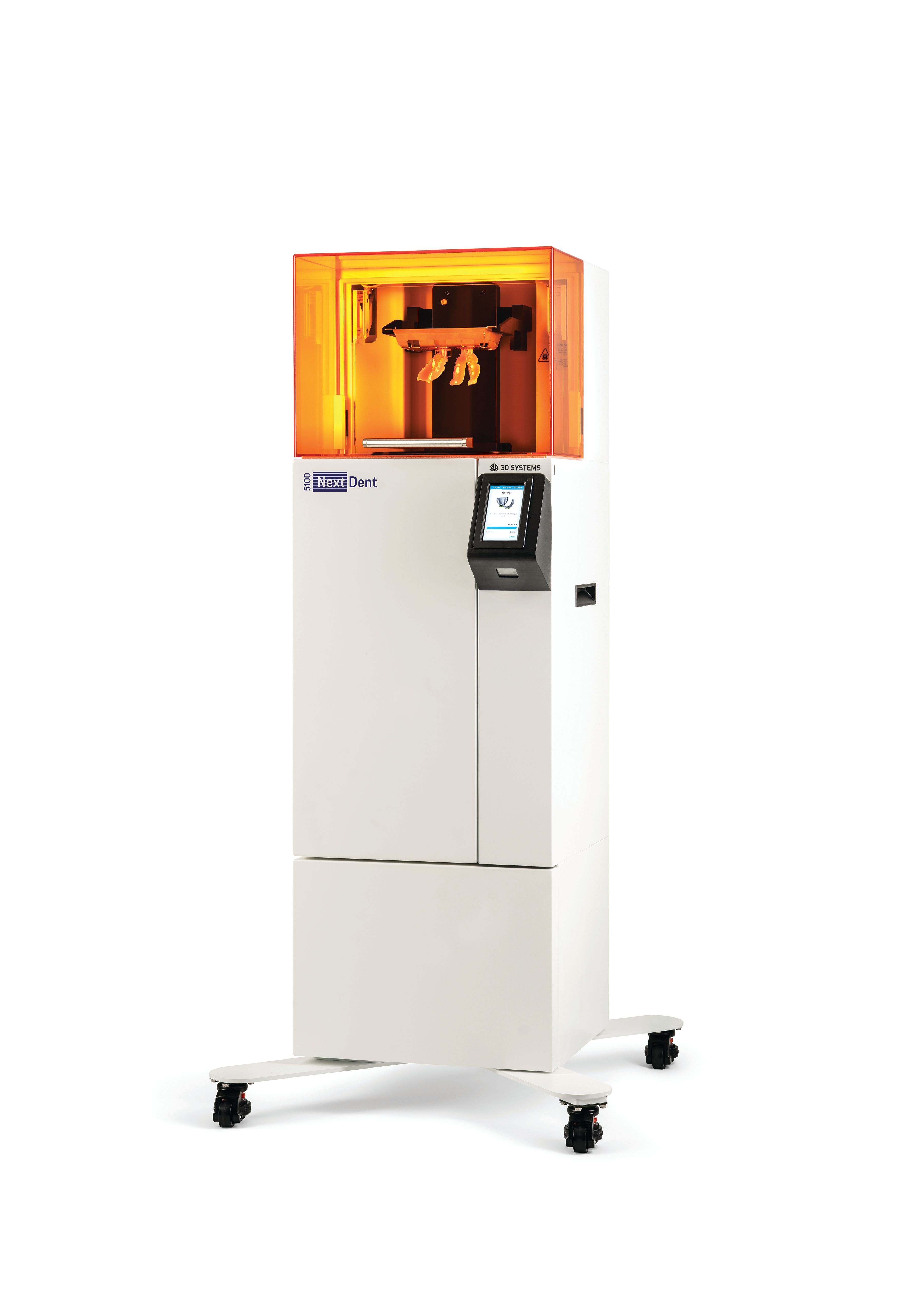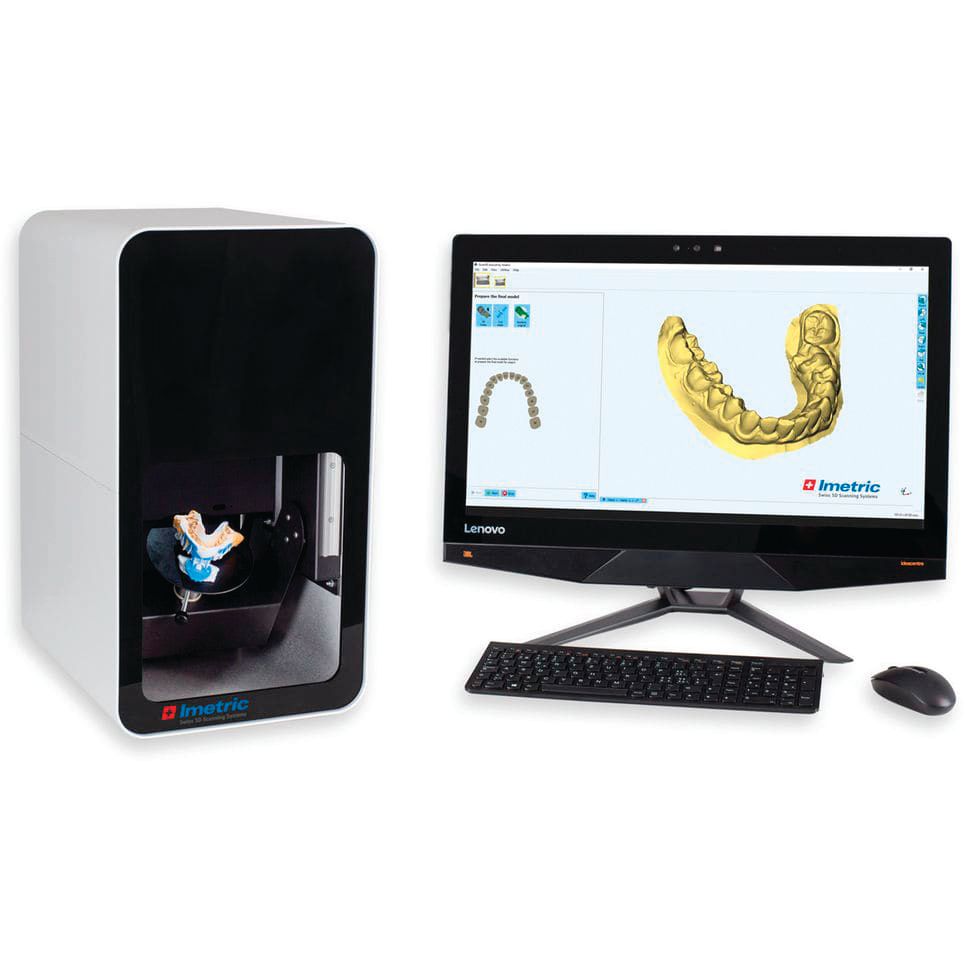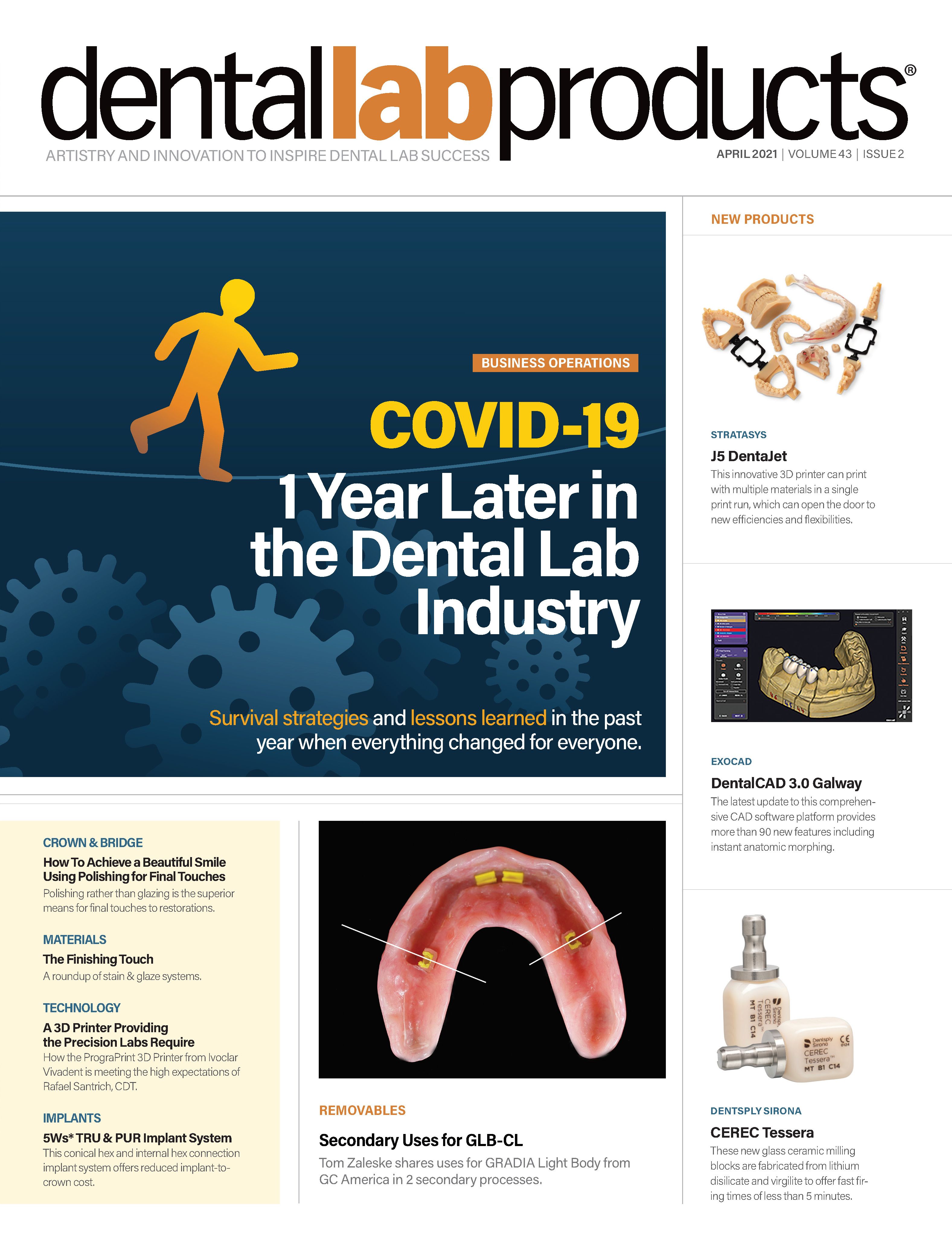COVID-19: 1 Year Later in the Dental Lab Industry
Survival strategies and lessons learned in the past year when everything changed for everyone.
DMITRY KOVALCHUK / STOCK.ADOBE.COM

On February 2, 1993, television weatherman Phil Connors traveled on assignment to Punxsutawney, Pennsylvania, to cover the annual shadow-sighting ceremony of Punxsutawney Phil, the groundhog said to predict whether or not to expect an additional 6 weeks of winter. That year, however, Connors found himself stuck in a seemingly never-ending time loop, repeatedly reliving the same day. The only way for him to end his ever-recurring day was to learn from his poor life choices and make positive changes.
During the pandemic, each day of 2020 may have felt like a version of Connors’ Groundhog Day. But unlike the movie, dental labs were able to apply the lessons they learned sooner rather than later.
How Labs Fared
In the early days of the pandemic, labs were forced to shut down. And although their work is necessary, the unpredictability of the situation led to anxiety about the future of some of them. Happily, however, those who were able to weather the storm saw business waiting for them upon their reopening. Even better, some saw even more business.
“We finished last year out with a surprising 12% over annual targets, that included a 2-month shutdown, with July 2020 being one of the biggest months in Absolute history,” Jack Marrano, CDT, director of signature prosthetics at Absolute Dental Services, says. “Currently, we are seeing an impressive trend of much of the same, finishing out January 2021 26% over target and on track to a record sales year at Absolute. I believe dentistry is still very much in part a luxury, and attribute the record sales to the patients who did not go to Europe this year but always wanted veneers. Many reports were from offices stating that large cosmetic cases have been walk-ins and not linked to hygiene.”
Others were able to take advantage of the unexpected time off to fine-tune their businesses.
“Looking back now, being shut down was a blessing in disguise,” David Turpin, owner of Spartan Dental Lab, says. “It allowed me to work on some projects that were pushed to the side, because being busy, production, and helping clients always took top priority. So the shutdown helped grow my business in a positive way. I was able to evaluate processes and procedures to improve how we would run the business when we reopened. Taking a step back really helped the overall health of my business.”
When his lab reopened, Turpin saw increased business.
“There was an uptick in certain products,” Turpin says. “Products like night guards and repairs—a ton of repairs, but this was expected seeing how our clients weren’t seeing patients for a little over 2 months.”
For more information on this topic, read the April 2021 cover story in Dental Products Report by clicking here.
For Ben Godfrey, an application engineer at Axsys Dental Solutions, what was going to be an exciting new business venture became an abrupt career detour.
“During the month of January 2020, I had been preparing to purchase my own equipment to start a B2B outsourcing facility with the savings I had put away over the years,” Godfrey says. “When COVID-19 hit, I got cold feet. I didn’t sign the papers and didn’t order the equipment. Instead, I used my savings to pay my bills; in July I took a new job to try and salvage some scrap of a life from this debacle and I landed at Axsys Dental Solutions. They were willing to let me work remotely, so I have been doing support calls by remote ever since. The 15 years of CAD/CAM knowledge that I have are now not going to waste.”
Taking Care of Business
Although the pandemic threw a curveball at a lot of industries, dental labs were already in a state of flux.
“The traditional business model was already changing, pre–COVID-19,” Bennett Napier, MS, CAE, executive director of the National Association of Dental Laboratories (NADL), explains. “One of the biggest trends could be the faster progression from traditional impressions to digital impressions, which mitigates some of the concerns relative to infection control in a COVID-19 environment.”
Observing proper infection control protocols was always important, but the pandemic has led to an increased focus.
“A renewed understanding by employers and technicians on proper infection control and general safety standards and protocols is now top of mind. Adherence will be the norm instead of a perspective that such standards are not just best practices and guidelines, [but] rather federal regulatory requirements,” Napier observes.
At some labs, COVID-19’s “new normal” meant employees found themselves taking on new duties.
Powered by Figure 4 technology, the 3D Systems’ NextDent 5100 printer facilitates high-speed 3D printing for production of dental appliances and sacrificial castings.

“I was worried, because I did have reduced staff when we were getting back to production,” Turpin says. “My dad and I were forced to help in areas where we would not normally be working. We were also training each member of our staff to help with tasks they weren’t used to doing before. Because of the reduced staff, we did extend our time schedules and ask for more time on cases that we normally wouldn’t have.”
The federal government extended a helping hand to businesses with the paycheck protection program (PPP), a $953 billion business loan program established through the Coronavirus Aid, Relief, and Economic Security (CARES) Act in 2020. The act’s goal was to help certain businesses, self-employed workers, sole proprietors, some nonprofit organizations, and tribal businesses continue paying their workers through low-interest private loans to cover payroll and other costs. The 2020 program ended on August 8, but was restarted on January 11, 2021.
Many dental labs successfully availed themselves of PPP loan opportunities.
“In the spring of 2020, the percent of NADL member labs that applied for the first round of PPP was significant,” Napier observes. “And results indicated [that of] those that applied, over 85% received funding. That program was extremely helpful to many labs to bridge a gap, given their dental client base was, in some cases, shut down for 8 to 10 weeks, depending on the states of operation of their core client base.
“Some labs did meet the qualifications for a second draw…of the PPP that launched in the close of 2020,” he continues. “However, the percentage of labs applying is much less than those [who applied] in the first round in the spring of 2020. A smaller percentage of labs applied for the Small Business Administration (SBA) Economic Injury Disaster Loan (EIDL) program.”
A lab’s size doesn’t appear to have had any effect on how well the lab fared during the pandemic.
“No data indicate that one size of lab fared better than the other,” Napier observes. “A lot came down to what cash reserves the lab had on their balance sheet, access to existing lines of credit, and access to or success in applying for programs such as the PPP. However, from a percentage standpoint, NADL has received more calls from smaller labs [1-10 employees] seeking counsel on buy or sale processes.”
Over the past 15 years, many dental labs have consolidated or closed. In 2004, according to the Bureau of Labor Statistics (BLS), there were 7855 dental labs in the United States. In 2019, there were 5701. By the second quarter of 2020, 5522 labs existed. COVID-19 may help hasten even more closures.
“The BLS market trends relative to lab consolidation clearly have sped up the pace of market consolidation,” Napier says. “The 2020 year-end figures will be available around June 2021. It would not be surprising to see 2020 reflect 750-900 labs closing or being acquired due to the economic impact of COVID-19.”
Looking ahead, the COVID-19 vaccine is a concern for many. NADL has lobbied for dental lab technicians to have the same priority in the vaccine line as dentists and other health care providers, with some success.
“NADL participated in a coalition letter in December 2020 seeking guidance from the CDC [Centers for Disease Control and Prevention]to ensure dentists and allied personnel, including dental laboratory technicians, were deemed to be in the first tiers of the vaccine line,” Napier says. “The CDC, in late December, did include ‘technicians’ in their report. Unfortunately, each state has its own plan on vaccine rollout, so even dentists in some states are still not eligible to get the vaccine, given state supply. However, NADL has found a number of states where dental laboratory technicians have been able to obtain their first vaccine due to a combination of factors. [As mentioned,] the CDC report and definitions of health care personnel…includes ‘technicians’, and, if a technician is working in a state where dental laboratories are regulated, that has been helpful to get them in the front of the line.”
Based on recommendations from the CDC’s Advisory Committee on Immunization Practices (ACIP), an independent panel of medical and public health experts, “...health care personnel be among those offered the first doses of COVID-19 vaccines. This includes all paid and unpaid persons serving in health care settings who have the potential for direct or indirect exposure to patients or infectious materials.
“This recommendation pertains to paid and unpaid health care personnel working in a variety of health care settings—for example, acute care facilities, long-term acute care facilities, inpatient rehabilitation facilities, nursing homes and assisted living facilities, home health care, mobile clinics, and outpatient facilities, such as dialysis centers and physicians’ offices.”
Technology to the Rescue
Another glass-half-full aspect to the pandemic is how technology has stepped up to rescue all sorts of businesses. For instance, 2020 became the year of Zoom meetings. Physicians and, to a certain degree, dentists were able to see patients via telemedicine or teledentistry, while dental labs saw a greater adoption of CAD/CAM workflows.
Developed by iMetric, the L1 series of scanners from Axsys Dental is suited for a range of indications.The L1 is the base model and is suited for scanning models and impressions and can be upgraded to either the L1m or the L1i.

“The severe restrictions brought [about] by the COVID-19 pandemic have positively impacted the adoption of 3D-printing workflows in dentistry,” says Stijn Hanssen, a sales, marketing and applications manager at 3D Systems Corporation. “In the early days, due to the stay-at-home orders, people were not able to visit their dentists, which left many doctors and technicians with time on their hands. They pivoted their businesses and used some of that time to educate themselves on the digital options to transform their practices, labs, and clinics through webinars and other virtual events offered by 3D Systems and other companies. Training and education is of the utmost importance for anyone changing their procedures to incorporate digital steps, and this ‘slow down’ proved to be the perfect occasion. They took advantage of the available information, mostly free of charge, from the comfort of their homes.
“With this new knowledge, more practices have incorporated digital into their workflows,” he continues. “The adoption of digital workflows, which begins with digital impressions, has gained popularity. Once the impression is taken digitally, 3D printing becomes a logical next step in the workflow. More digital scans result in more models to print. The application of 3D-printed models has significantly grown since the start of the pandemic. Moreover, the printing of try-in dentures and overdentures, surgical guides, and splints can be done without the need of a model. Patients are benefitting from less chair time and fewer office visits. In times of social distancing, and minimizing direct contact [with] people being so important, this proves to be very beneficial for dentists, technicians, and their patients.”
Some labs have expanded their digital infrastructure to respond to the growing demand.
“Even in these uncertain times the sale of 3D dental printers has hardly been impacted,” Hanssen says. “We even see labs purchasing a second or third printer to increase production. When more impressions are taken digitally, more parts need to be printed by the lab, growing the total volume. Generally speaking, we believe the adoption of 3D printing technologies was already high in dental laboratories. Since the start of the pandemic this has only increased further.”
Relationship Revolutions
But it isn’t just the lab embracing digital technologies. Doctors, even those who were formerly reticent to do so, have started gravitating toward digital tools, such as intraoral scanners.
“I have seen an increase, within the last 10 months, in intraoral scans,” Turpin says. “Some dentists that didn’t want anything to do with intraoral scanning are now requesting more information. They want information on which one would work best with our workflows here at the lab to be a streamlined process.”
And that interest has been a welcome move for Turpin.
“It’s definitely a good thing,” he says. “We’re able to cut down on shipping costs and initiate the production process faster. On the dentist’s side, it’s easier for infection control purposes. We’re also not transporting impressions.”
Those workflow changes can be encouraged by the lab, but must be initiated by the dentist.
“I believe the majority of the doctors implementing digital workflows are doing this mainly on their own,” Hanssen says. “They recognize the advantages of using this digital technology to minimize patient contact, improve hygiene, and in general offer a better treatment to their patients. Labs that were already able to receive digital files and had included CAD software and 3D printers in their workflows haven’t had problems in supporting their doctors with their move to digital.”
Infection control has changed both in-house and when visiting client doctors.
“Everything from new disinfected packaging for outgoing cases to custom shade appointments, many protocols have been put in place,” Marrano says. “The most notable is the disinfection throughout the lab using hypochlorous acid. Many studies have been done on this nontoxic agent and its strength is many times stronger than bleach. Every surface in the entire laboratory is treated using hypochlorous acid 4 times a day with the aid of a fogger.”
For relationships that persist in which lab technicians must have any sort of physical contact with a doctor’s office, whether going in person or accepting physical impressions, interactions have necessarily changed.
“At first, some of my employees were kind of nervous, especially my office staff that handles the incoming impressions,” Turpin says. “We’ve optimized the isolation and disinfection protocols of incoming impressions. Before COVID-19, it appeared [that] some dentists [didn’t] spray their impressions with a disinfectant before they…put it in a safety bag. Now I’ve seen more and more cases arriving in safety bags with a liquid in the bag.
“When I go to an office, I have to follow protocols,” he continues. “I have to either call or text someone in the office that I’m there to help out. When they allow me to come in, they’ll take my temperature. Some offices, depending on the procedure, have asked me to wear a gown, N95 [respirator], and a face shield in the patient rooms. These protocols take a little more time, but it’s all to keep everyone safe. It’s a nice feeling to know they trust me as the technician and still welcome me in the office to help.”
“I never used to really engage with the dentists at any of my previous employments; however, more dentists are now looking to labs for support than ever before and on a whole new level,” Godfrey points out. “I am seeing many labs get absolutely inundated with work because the doctors, too, are playing catch-up to their many patients who needed dental work over the lockdown periods. I don’t expect this to change, either, because there are also a lot of labs that couldn’t survive lockdown or a reduction in business and went out of business. The remaining labs will be swamped for a long time, as doctors prep to run in-house milling and printing facilities or adopt in-house techs to run them.”
Within the lab, however, Godfrey sees a lot of the workflows remaining as they have been.
“In terms of lab workflows, nothing should really have changed from what should have been normal to begin with (and was normal at the labs I worked at),” Godfrey says. “Every case should already have gone through disinfection protocols, and lab workers should have already been wearing gloves and masks to avoid the silicate dust in the air from model grinding and divestment procedures.”
Human Resources
The business of dental labs has changed because of the pandemic, but so has the personnel side.
“All staff have their temperature scanned immediately upon arrival. Masks are mandatory, with technicians being spaced 6 feet apart or greater with plastic barriers placed between them,” Marrano says. “Technicians are encouraged to wash their hands regularly.”
“I expect many labs will have gone through a terrible phase of restructuring of personnel, or limiting COVID-19 exposure through shade appointments, now done digitally—which is not ideal, but still workable,” Godfrey adds. “Limiting exposure by requiring the 6-foot rule is difficult to implement, but still workable for the larger labs that may already have to shift work in place.”
In spite of the best faith efforts to avoid transmission, some labs have been affected by COVID-19.
“I had 3 individuals, including myself, test positive,” Turpin says. “One individual is one of my delivery drivers. My office staff did an amazing job stepping up to help fill the gap. They would alternate each day helping run routes. This teamwork made it so it so we weren’t struggling with the absence.”
In another example of making lemonade out of lemons, Turpin saw his illness as an opportunity.
“Now, when I tested positive, we had to change a lot, fast,” he says. “It was a challenge at first, but I was able to work from home. So I built a computer that is powerful enough to handle our design software, and I would pull reports from our management software to see what needed to be designed. I would design it and send it back to the lab and they would complete the rest of the production steps. It actually worked out very, very well. I never thought in a million years I could stay home for as long as I had to.”
Those changes persist, to the benefit of his business.
“My goal is to stay home at least once a week, because during that time, I had fewer distractions at home—surprisingly, because I have 2 toddlers,” Turpin says. “I actually get more work done when I stay home. I am able to accomplish more administrative tasks and work on the business at home compared to when I’m at the office. Without distractions, I’m able to focus on sales, marketing, and completing the important tasks to advance my business along.”
Like other businesses, dental labs have felt the impact of the pandemic.
“Everyone had, and still has to, adapt to the rules and restrictions that are in place globally,” Hanssen says. “Traveling has been almost impossible since March 2020, so we have found new ways to connect with our partners and customers. While nothing can replace the value of being at a trade show to physically show products and workflows to potential customers, webinars and social media are now the most important communication channels. In addition to keeping communication open, these new ways of communication have additional advantages. For example, even if a webinar is not attended at the scheduled time, there is an opportunity for it to be viewed later. Additionally, transitioning an event to virtual from in-person also expands the reach. Now we have the opportunity to interact with a broader base of people, and collaborate with them to transform their digital dentistry workflows.”
For a while, dental lab owners and technicians may have felt like they were living in their own version of Groundhog Day. But, like Phil Connors, they can view coming out at the end with optimism and encouragement.
Says Hanssen, “While we are happy with how we’ve been able to pivot during the pandemic, I assure you that we can’t wait to meet everyone again in person soon.”
